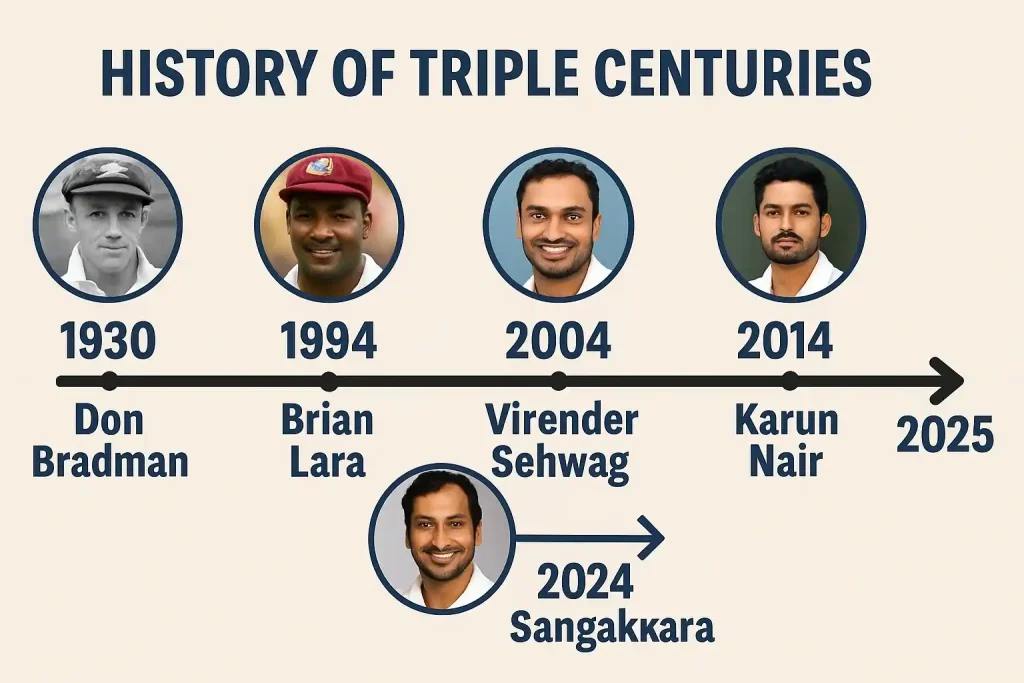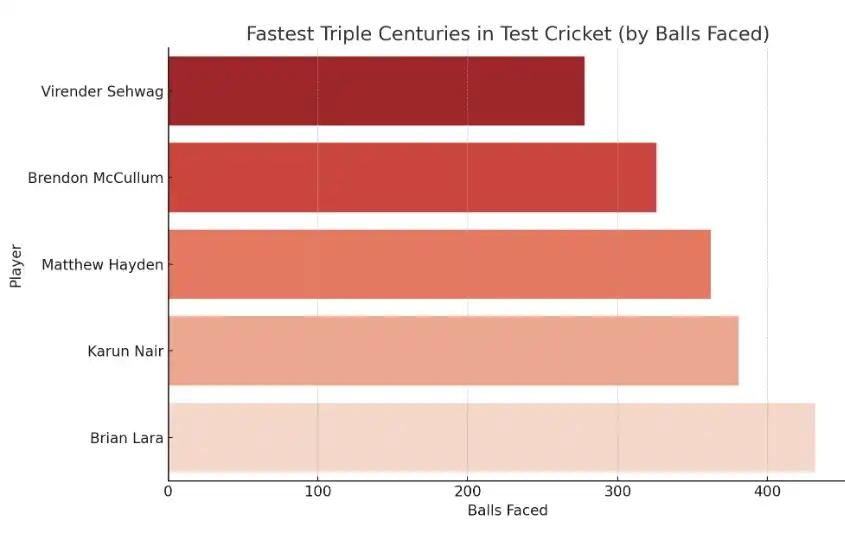
Test cricket has an odd romance with the number 300; fans whisper it with almost religious reverence. The roundness of the figure is pleasing and accurate, but that isn’t the real magic. A triple ton asks for more than night-watchman luck or a brief hot streak. What it needs is relentless concentration, stubbornness, and a willingness to pretend that time does not exist. Bowlers change ends, lunch breaks arrive, shadows lengthen, and yet a single batter refuses to leave the crease.
To feel the gravity of three hundred, you must reckon with everything Test cricket demands. The task is bigger than accumulating runs; it is learning to ignore clocks, fading light, and restless spectators. The crowd shrinks, the fielders shuffle like tired sentries, and even the commentators begin recycling metaphors, yet that lone batter keeps performing. Scoring a triple century becomes less a batting display and more a sweaty, dusty marathon recorded in disbelief rather than in simple minutes.
Where Triple Centuries in Test Cricket Live in Memory
I remember Virender Sehwag’s 319 in Chennai not because of the number, but the way he got there. Swagger intact. Feet moving just enough. And that devil-may-care attitude that made bowlers nervous before he even took guard. Or Brian Lara’s 400* — not just a score but a monument. That innings wasn’t about dominance. It was about presence. About staying. And staying. And staying.
Each of these innings feels different. Some were brutal — Hayden’s 380 against Zimbabwe was pure force. Some were sculpted with elegance — like Sangakkara’s 319. And then there are those that surprise you: a day-three miracle when the pitch is starting to crack, and a batter finds his zone for 10 hours straight. These are the days when the game bends to one man’s will.
Table 1: Top Triple Centuries in Test Cricket (Selected Records)
| Player | Score | Opponent | Venue | Year |
| Brian Lara | 400* | England | St. John’s | 2004 |
| Matthew Hayden | 380 | Zimbabwe | Perth | 2003 |
| Brian Lara | 375 | England | St. John’s | 1994 |
| Virender Sehwag | 319 | South Africa | Chennai | 2008 |
| Chris Gayle | 333 | Sri Lanka | Galle | 2010 |
| Sanath Jayasuriya | 340 | India | Colombo (RPS) | 1997 |
Notice how most of these were scored at home. There’s something about familiar soil, known breeze, the smell of local turf that gives batters that extra thread of patience. But don’t be fooled. These innings were still battles. Hayden may have been smashing a weakened attack, but he still had to concentrate for over 600 minutes. Try doing anything with discipline for that long, and you’ll understand.
The Grind Behind Triple Centuries in Test Cricket
Here’s what the stats don’t show you. The sore back. The dry throat. The moment after 150 when the mind says, “That should be enough,” and the will says, “Not yet.” Batting for three sessions is hard. Four is brutal. Five? That’s something else.
Fitness plays a huge role, yes. But so does routine. Sehwag once said he focused on five runs at a time. Not milestones. Not records. Just the next five. And then again. And again. That’s how a triple hundred is built: not in boundaries, but in breath control, muscle memory, and an almost meditative rhythm.
How Rare Are Triple Centuries in Test Cricket?
In over 2,500 Tests, fewer than 35 triple centuries have been recorded. That’s less than two percent of all centuries. Think about that. A feat so rare that entire generations of cricketers never come close. Not Sachin. Not Ponting. Not Kohli (yet). That’s what makes the 300-club so elite. It doesn’t bow to talent alone. It requires time, temperament, and tenacity.
Table 2: Countries with the Most Triple Centuries in Test Cricket
| Country | Number of 300+ Scores | Notable Players |
| Australia | 8 | Bradman, Hayden, Clarke |
| West Indies | 9 | Lara, Gayle, Sobers |
| India | 4 | Sehwag, Karun Nair |
| Sri Lanka | 4 | Jayasuriya, Sangakkara |
| England | 2 | Hammond, Gooch |
| Pakistan | 4 | Younis, Hanif, Azhar |
| New Zealand | 1 | Brendon McCullum |
This isn’t just trivia. It tells a story. Of pitches that help, of domestic structures that reward long innings, of cultures that value patience. Triple centuries don’t come from nowhere. They come from systems.
The Psychology of a Triple Ton
Ask any batter who’s crossed 300, and they’ll tell you the weirdest part is not the runs. It’s the time. The way the world fades. The way bowlers blur. The way crowd noise becomes a background hum.
At some point, the scoreboard becomes irrelevant. You’re just playing. Ball after ball. With every delivery, you’re telling the game, “I’m still here.” And when it clicks, when form and focus align, the bat becomes an extension of thought.
But even then, one lapse is enough. That’s why so many players fall short around 290. It’s not nerves, it’s the brain short-circuiting. After eight hours, you forget to duck. Or you chase a wide one. That’s the beauty and tragedy of it.

Modern Cricket and the Future of Triple Centuries
Some argue that T20 has ruined the art of the long innings. Maybe. But others say it has sharpened batsmen’s instincts. They rotate better. They find gaps quicker. They score faster. That’s why Karun Nair’s 303* in 2016 felt like a throwback wrapped in a modern tempo.
But will we see many more? That’s tricky. With packed schedules, flat tracks are rarer. Bowling attacks are deeper. And teams declare earlier. All this works against the idea of a triple ton. But then again, cricket has a way of surprising you. Who thought David Warner would get 335 in 2019? On a deck that offered nothing?
Final Thoughts: Why We Remember Triple Centuries in Test Cricket
Amid highlights and social clips, scoring three hundred runs in a Test feels like watching a proper film rather than a trailer. You do not simply glance at the score; you settle in and follow every ball, every decision made under fading light. As the innings stretch, expectation tightens. Commentators soften their voices; spectators raise theirs; time slows and starts to resemble another era when matches could drift for days on end.
Triple centuries remind players and fans alike that lasting achievement cannot be hurried. It asks for extreme concentration, an awkward blend of cool self-discipline and the reckless spirit needed to ignore pain and fatigue.
Then, hovering between two hundred ninety-nine and three hundred, the atmosphere tilts. Statisticians perk up, cameras zoom in, and with that single decisive stroke, the batsman crosses from skilled professional into folklore.

Meet Arjun Kushaan, a passionate cricket analyst at The Cricket24x7. From street matches in his childhood to competitive college tournaments, cricket has always been a central part of Arjun’s life. With a strong background in data analysis and a natural affinity for numbers, he brings a fresh, analytical lens to the game. At The Cricket24x7, Arjun blends his deep love for cricket with his data-driven approach to deliver detailed insights and well-rounded coverage for fans of the sport.






